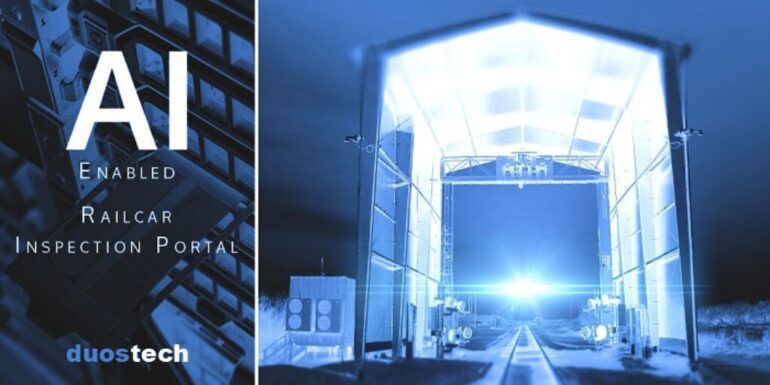TL;DR:
- Railways are transitioning to AI and ML-based railcar inspections, necessitating HPC clusters, storage, and analytics for real-time results.
- Duos Technologies, with Dell, Kalray, and NVIDIA, pioneers the Railcar Inspection Portal (RIP) for mechanical railcar inspections.
- Traditional manual inspections take 3-4 hours for a 120-car train; RIP reduces this to minutes with enhanced accuracy.
- RIP deploys high-resolution cameras, generating 60GB/s of data, ingesting in real-time, and offering 895TB usable capacity.
- The system utilizes Dell servers, NVIDIA GPUs, and high-speed image compression via NVIDIA SDKs.
- Duos RIP facilitates remote system management and administration.
Main AI News:
In the ever-evolving landscape of railway operations, the shift from traditional inspection methods to cutting-edge technologies has become an imperative. Industries are increasingly turning to artificial intelligence (AI) and machine learning (ML) for the automation of railcar inspections. High-speed data streaming from the edge necessitates the computational prowess of a High Performance Computing (HPC) cluster, combined with advanced storage and analytics capabilities, all operating in real-time. Furthermore, remote administration and management functionalities are paramount to ensure the uninterrupted and dependable operation of such systems.
Duos Technologies, in a dynamic collaboration with Dell Technologies, Kalray, and NVIDIA, has pioneered a groundbreaking solution known as the Railcar Inspection Portal (RIP). This innovative system leverages the power of AI and ML at the edge to revolutionize wayside mechanical railcar inspections.
Challenges in Traditional Railcar Inspection Methods
Traditional railcar inspection methods have posed considerable challenges for the railway industry. Regulations mandate that railcars undergo inspections before each journey to rectify any identified issues. Manual railcar inspections, however, are a time-consuming affair, with an average rate of inspecting just one railcar every two minutes. Given that a typical freight train consists of 120 railcars, the entire inspection process can take a daunting 3 to 4 hours.
Introducing the Duos Technologies Railcar Inspection Portal (RIP®)
Duos Technologies introduces a paradigm shift in railroading, logistics, and intermodal transportation operations with the Duos RIP®. This modular visualization system provides real-time, detailed 360-degree imaging of railcars while they are in transit, hurtling along at speeds of up to 125 miles per hour. The data is generated by an extensive array of high-resolution cameras meticulously mounted on a truss that spans the track.
The RIP solution deploys an array of high-speed machine vision cameras that generate an astonishing aggregate of over 60 gigabytes per second of data. It’s imperative that the system can ingest raw data in near real-time while simultaneously producing and storing usable images at a rate of 20 gigabytes per second. Additionally, the system must be capable of immediately initiating the feeding of these images through AI and ML pipelines, all while efficiently ingesting and pre-processing the remaining train images. Notably, the RIP boasts a remarkable 895 terabytes of usable capacity, with an astonishing data ingest rate of over 80 gigabytes per second and a read performance exceeding 100 gigabytes per second.
The Ripple Effect: Transforming Railcar Inspection
The implementation of the RIP system has ushered in a new era for railcar inspections. It has dramatically reduced the inspection time from a lengthy 3-4 hours to a matter of minutes, leading to a substantial increase in accuracy when identifying potential defects.
Innovative Technologies at the Core
The RIP system’s speed and data volume necessitates specialized storage and capture systems to handle the colossal amount of data and the high-resolution images involved. Duos Technologies employs a comprehensive solution from Dell Technologies, seamlessly integrating technology from Kalray and NVIDIA. A bank of 14 Dell acquisition servers plays a pivotal role in capturing images from the camera array and subsequently writing the data to the storage platform. These servers, excluding a pair dedicated to storage management, are all Dell PowerEdge R750-servers. Multiple NVIDIA GPUs deliver lightning-speed throughput for the rapid processing and analysis of data in mere microseconds. The entire hardware infrastructure is interconnected via an NVIDIA InfiniBand Network. The solution harnesses NVIDIA SDKs to achieve high-speed image compression through NVIDIA GPUs, along with NVIDIA CUDA SDKs powering AI algorithms.
Seamless Management and Administration
The heart of the RIP solution lies in its efficient server management software. It utilizes the Dell Open Management system in conjunction with Kalray server management software, featuring 2x Ngenea NG-Stor management nodes and 4x Ngenea NG-Box NVMe nodes. This comprehensive solution empowers users with the ability to remotely manage and administer the system, conduct health checks, and ensure optimal performance of the RIP system.
In the words of a Duos Technologies spokesperson, “I am very proud of what we have been able to achieve with the Dell and Kalray teams.” The Railcar Inspection Portal stands as a testament to the relentless pursuit of innovation and excellence in the railway industry, transforming traditional inspections into a seamless, efficient, and high-performance operation.
Conclusion:
The Railcar Inspection Portal signifies a significant leap in railcar inspection efficiency. By embracing AI, ML, and cutting-edge technology, it drastically reduces inspection times, enhances accuracy, and streamlines operations, offering a promising solution for the railway industry. This innovation is poised to drive market adoption of advanced inspection systems across the rail industry, saving time and resources while improving safety and reliability.

